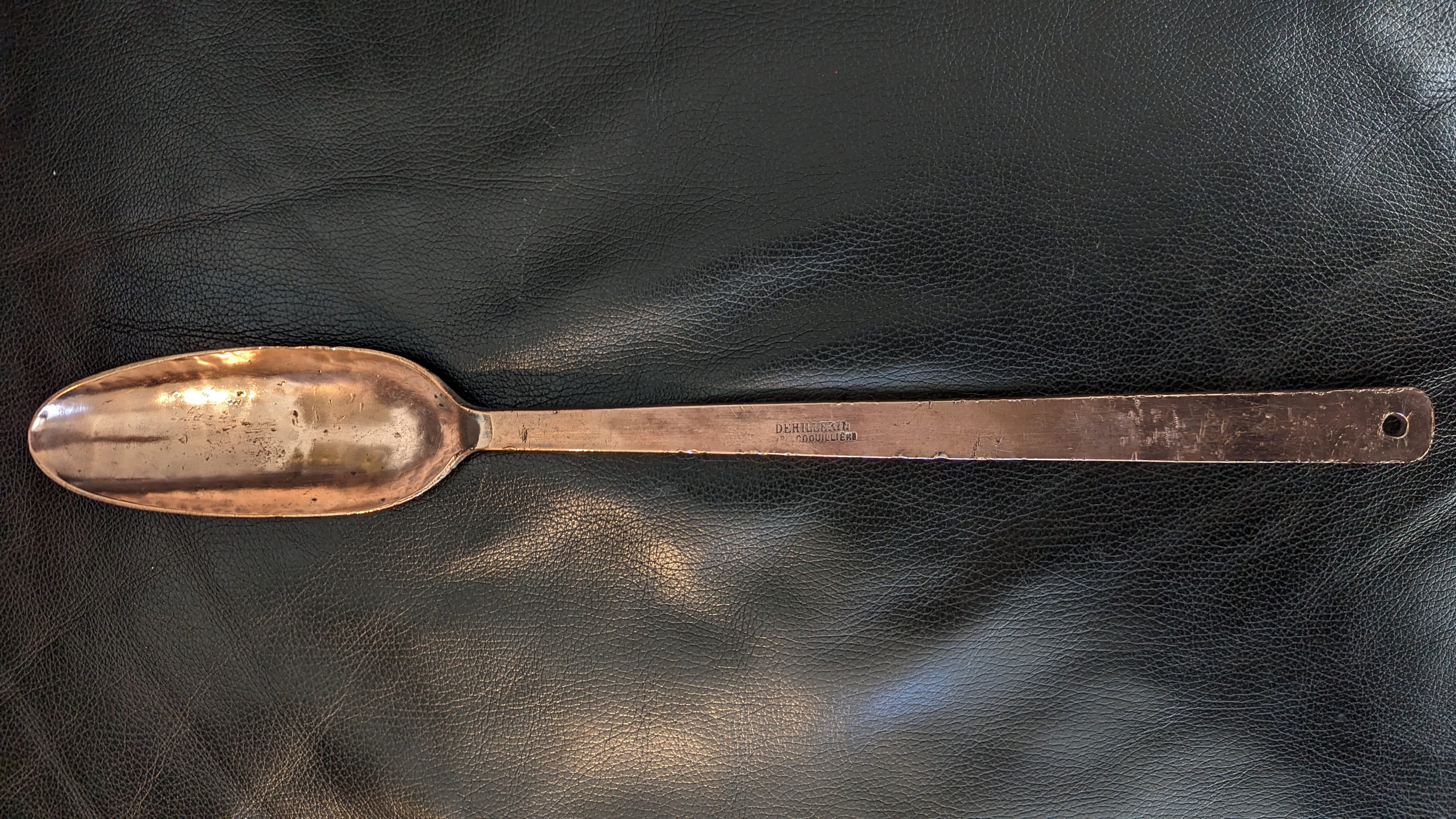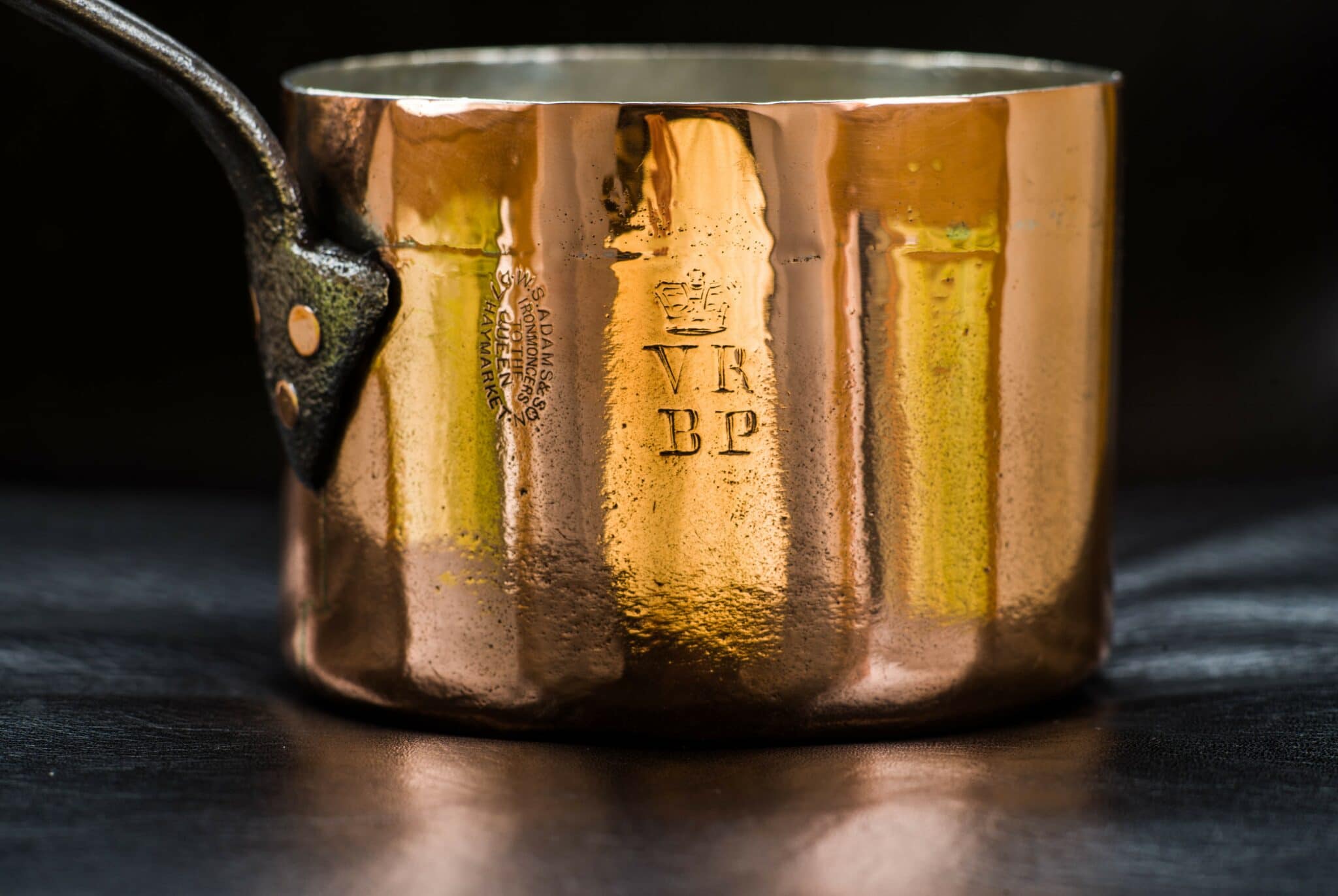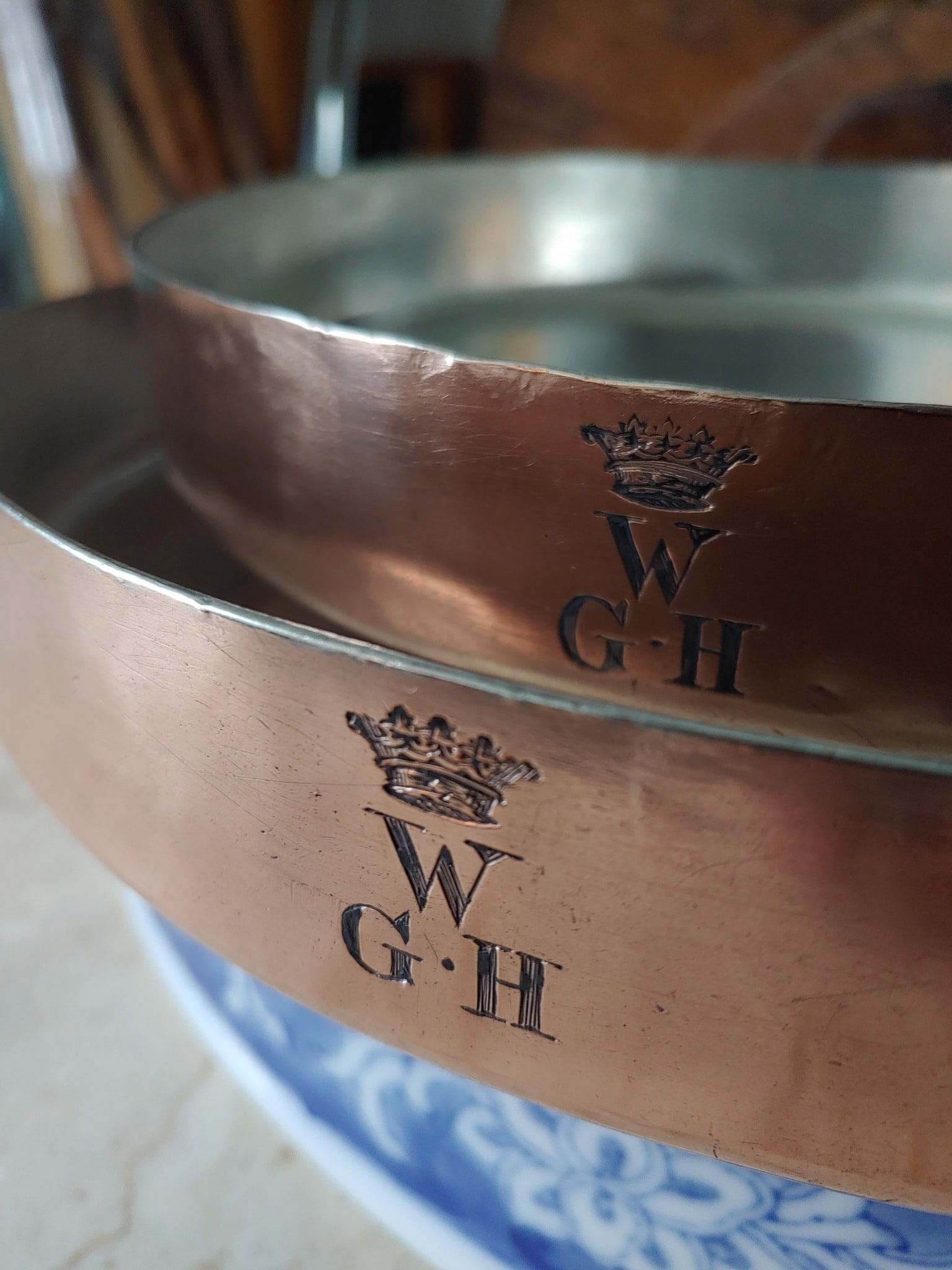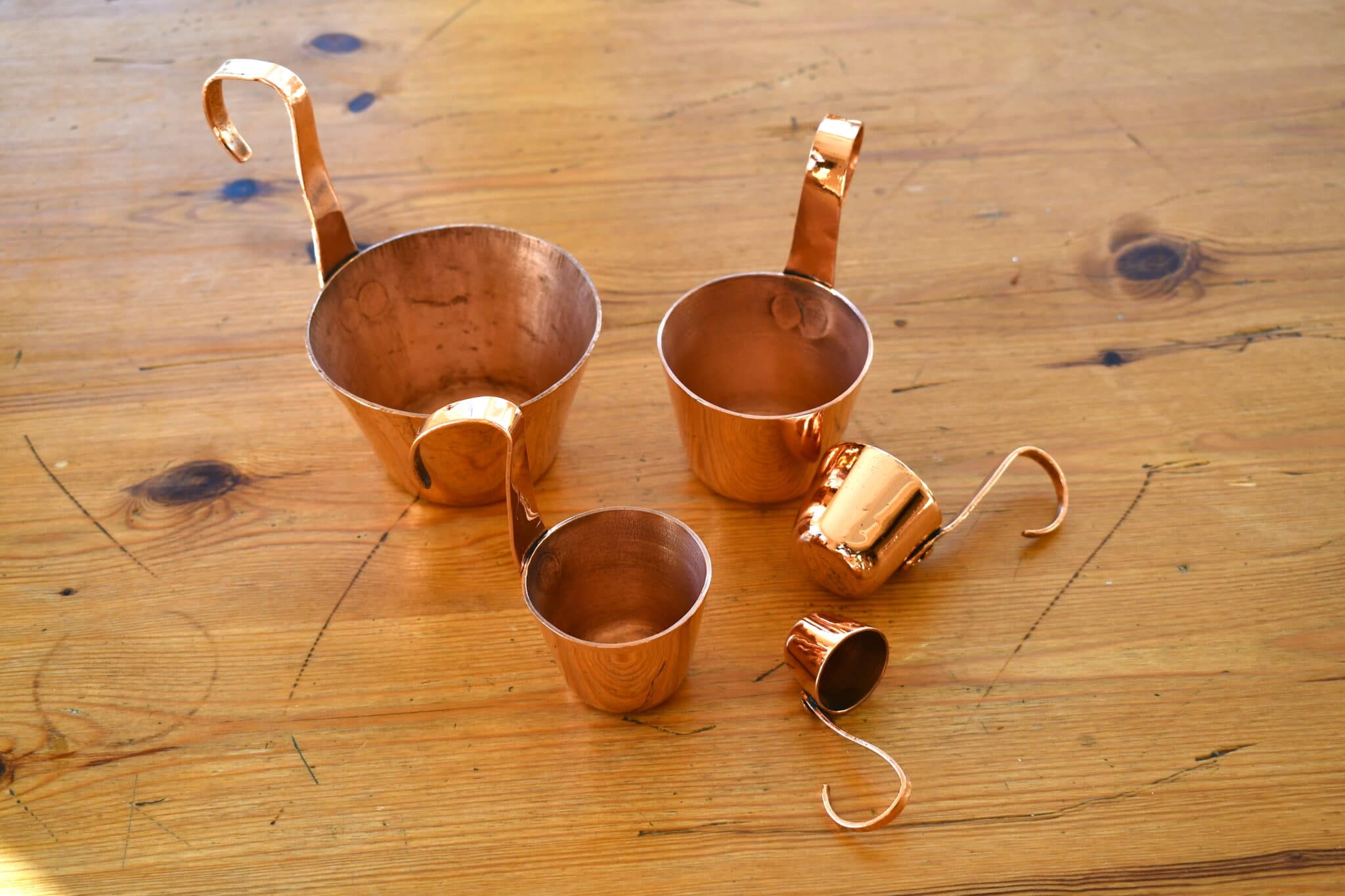I just love these things.
| Type | Five hammered aluminum saucepans with cast iron handles fastened with three aluminum rivets | ||||
| French description | Cinq casseroles en aluminium avec queue de fer munie de trois rivets en aluminium | ||||
| Dimensions | 18cm by 10.5 cm (7.1 by 4.1 inches) | 20cm by 11.5cm (7.9 by 4.5 inches) | 22cm by 12 cm (8.7 by 4.7 inches) | 24cm by 13.5cm (9.4 by 5.3 inches) | 26cm by 14cm (10.2 by 5.5 inches) |
| Thickness | 4.5mm | ||||
| Weight | 1200g (2.65 lbs) | 1544g (3.4 lbs) | 1710g (3.77 lbs) | 2074g (4.57 lbs) | 2388g (5.26 lbs) |
| Stampings | DEHILLERIN PARIS | Gransart Rouen | DEHILLERIN PARIS | ||
| Maker and age estimate | Unknown; 1900-1920, possibly 1940s-1960s | ||||
| Source | lazylou2002 (eBay) | ||||
There’s a reason virtually all restaurants use aluminum pots and pans — it’s a great material for cookware. Aluminum is lightweight, plentiful, and inexpensive, and it shares many of copper’s useful thermal properties. It was a French engineer who first purified it in 1856; in 1886, Paul Héroult and Charles Martin Hall developed the Hall-Héroult process to refine aluminum on an industrial scale, and their process is still in use today. Looking at the catalogs of French department stores, I see aluminum pots and pans first showing up in the early 1900s, and they continued to be produced into the 1960s.
And I adore them, particularly ones like these that look just exactly like copper pots, but silvery. I think they’re fabulous. (You may recognize these particular ones from my field guide to Mauviel — I fell in love with them and ended up buying them.)

Compare the 20cm aluminum saucepan below next to the same size in copper. There are some minor differences in the shape of the handle — this aluminum pot is likely a few decades older than this copper one — but they have the same unmistakeable French aesthetic.



One distinction is that these aluminum pots are 4.5mm thick, far thicker than the equivalent piece in copper. By mass, it takes about twice as much aluminum to match the thermal performance of copper, which means that these 4.5mm aluminum pots perform about the same as 2.25mm copper pots. But aluminum weighs far less than copper: the 20cm saucepan above weighs 1544g (3.4 lbs), while the 3mm copper version weighs almost twice as much — 2895g (6.4 lbs).
But there is also a downside to unlined aluminum pots: they can pick up discoloration and pitting with use. Aluminum is a highly reactive metal, but instantly forms an invisible layer of aluminum oxide the moment it comes into contact with the oxygen in our atmosphere. This oxide layer seals the aluminum off from further reactivity, but the acids and compounds in food can strip off the oxide layer and expose the underlying aluminum once again.
My set of pots has definitely been used, and the inside surfaces are pocked and discolored. I don’t think this is harmful, but it’s certainly a bit unsightly. The problem is that aluminum will react with many household cleansers — think of aluminum baking sheets that turn dull gray in the dishwasher — and I don’t know a way to clean the insides of these pots that won’t also discolor the surface. If you have a solution, please let me know in the comments!




Four of the five are stamped for Dehillerin, while the 20cm is stamped for Gransart Rouen. I’ve covered Dehillerin in a field guide; I’m fairly certain that this stamp on a copper pot means it was made after the 1940s and not by Dehillerin.


Gransart Rouen refers to a former culinary supply store in Rouen, the regional capital of Normandy. Arsène Auguste Gransart (1847-1927) came from a family of weavers in Cambrai, but in 1890 he purchased a knife-making operation in Rouen. He and his son Albert Gransart (1876-1941) operated “A. Gransart et Fils” until 1909 when Arsène retired. Albert renamed the firm “Société Gransart Frères Successeurs” and ran it with his son Jean Gransart (b. 1908). According to the family genealogy, the company “manufactured and marketed machines, motors, mills, and choppers for grocers, bakers, butchers, fisheries and communities. The store was located at 47 and 49 rue Lafayette with workshops at Lemire Street.” I don’t know how long the firm existed but I found mention of it as late as 1962.
I’m not entirely sure who made these pots but I’m pretty sure it wasn’t Dehillerin or Gransart. The obvious candidate is Mauviel but Gaillard is a possibility as well, or even Multiform, the metal shop that opened in Villedieu in 1947. I have a few other pieces with interesting stamps and I’m trying to make sense of it. I will advise when I learn more.
But whoever made them, they’re gorgeous. I asked Erik Undiks at Rocky Mountain Retinning to polish them and he did a great job. The photo below on the left is from the listing on eBay; you an see how scratched up the surface of the pots was. On the right is the polished surface Erik produced, but in such a way as to preserve both the hammering as well as the character marks. (Unfortunately his polishing equipment is too large to fit inside the pots, so he was unable to polish the interiors.)


I find these pots incredibly charismatic. I know that’s an odd thing to say about cookware, but there it is.







